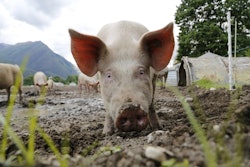Last March, rapid snowmelt accompanied by heavy rainfall left nine major grain-producing states – from Nebraska to Wisconsin – under water from massive flooding, with river levels exceeding all-time records in several areas.
This type of event underscores the need to have a plan in place in case flooding affects your grain facility or feed mill.
The historic flooding this past spring destroyed homes, businesses and claimed at least four lives.
Officials in Nebraska estimate that over $800 million has been lost in ranching and row crops. In Iowa, there was more than $214 million in damages to agriculture alone.
Maxar Technologies used Sentinel-2 imagery and the 2018 USDA/NASS Cropland Data Layer to analyze how much potential corn and soybean acreage was overrun by flooding this spring.
“We estimate that more than 400,000 acres that produced corn and soybeans last year were inundated during this flooding event,” says Jorge Cardona, senior imagery analyst for Maxar.
More than 500,000 acres of land was flooded in total, including 211,684 acres where corn was grown in 2018 and 226,809 acres where soybeans were grown in 2018.
Flooding damage
For agribusinesses and grain elevators, more devastating than the lost crops is the damage to equipment at these facilities, says Dr. Charles Hurburgh, Iowa State University professor, agriculture and biosystems engineering, and professor in charge, Iowa Grain Quality Initiative.
Any equipment at or below ground level will be affected, says Hurburgh.
“The amount of grain lost in the overall scheme will not be that big of a deal,” he says. “But the damage done to storage structures and equipment at facilities will be. You can write off any electrical equipment. Equipment damage will be the great impact from these floods for agribusinesses.”
All types of commercial grain businesses from grain elevators to feed mills to ethanol plants were affected by the flooding in the region. Whether your agribusiness was impacted by the recent floods or not, it’s always best to be ready if such an event happens.
Flooded structures
After a flooding occurrence, you’ll have to wait for the water to subside to assess the damages to structures, foundations and other equipment.
Floodwater can affect the grain a foot or more above the flood water level. This wet grain will fluidize and swell, causing bin wall pressure to increase two to three times normal pressures observed with stored corn and even more with soybeans.
Damaged bins can be dangerously waiting for collapse or serious failure without warning. All inspection should be done visually from a safe distance before approaching the bin.
The following basic check list is from Jerry L. Wille, PE, president of Curry-Wille & Associates, for preliminary evaluations of the grain bins and equipment after flooding.
Wille says there are frequently different standards and situations that arise with commercial bins that need to be considered with repairs and replacements.
“A professional should be called any time there is any questions about what has happened or what needs to be done,” he says. “If someone is unsure about needing a professional, call the professional and ask them. A true professional will have an opinion if they are needed based on the conversation.”
Steel Bin
- Visually determine if the bin is bulging or if grain is leaking out of the sidewalls. This is an indication of the bin failing or continuing to fail and is an extremely serious situation that could suddenly burst open. If this situation is found, discontinue any contact with the bin and seek professional assistance as soon as possible.
- Look at the bin from a distance to see if it’s leaning or has any damages associated with impacts from floating debris.
- Corrosion will not occur for some time after the flood, but water will frequently accentuate previous corrosion, particularly along the bottom sheets and anchorage.
- Check bin wall access doors for alignment and if they are not closing or fitting properly or if there are missing bolts.
- Slightly move slide gates to see if they are plugged or jammed with flood debris. Do not open them all the way until the handling equipment has been evaluated. Simply move them to determine if they are free. Check for missing or sheared stiffener or bin wall bolts. If any bolts of this type are found, discontinue any contact with the bin and seek professional assistance as soon as possible.
Foundations
- After assessing the bin, check the exposed concrete for any cracks. Particularly cracks that are offset indicating a shearing of the concrete.
- Look for any tilting or settlement of the foundation. This may be more obvious by leaning of
- the bin. It may also indicate soil settlement problems.
- Frequently running water around the bin (surprisingly even at
- low flow rates) will cause the soil to be washed out under the bin foundation. If this situation is found, contact a professional. Simply replacing the washed material
- will not re-establish structural stability.
- If soil correction was done for construction of the bin and foundation, there is a higher probability that the soil conditions have changed due to flooding.
- Check anchor bolts to see if any are pulled out, sheared off or the bolt is breaking off the edge of the concrete. This is an indication that the flooded grain has caused the bin move and a professional will need to evaluate the extent of the damage.
Handling Equipment
- Drain and clean out all equipment before any operations. Do not simply run the equipment to remove the water because this will likely result in damage to the equipment and the grain.
- Check all bearings for rust and pitting and re-lubricate.
- Check all components for corrosion and debris. The tails of augers and conveyors as well as bucket elevator boots are prime locations for old grain to become soaked with flood water.
- Check all aeration tunnels and chairs for corrosion and debris.
Electrical
- Turn off all power before accessing any portions of the bin, drain all water, and call a qualified electrician
The outlook for summer
According to Maxar’s Weather Desk, a wet spring with above-normal precipitation
will give way to a seasonal summer.
“There will be pockets of above-normal temps across the nation, but as a whole, summer will be seasonal,” says Chris Hyde, meteorologist at Maxar Technologies.
Hyde says Maxar is predicting better production for producers this summer. “Corn, year-on-year, will be up 4%, soybeans might be down 4%, and wheat will also be up,” he says.
Given that these extreme weather and flood events will occur more frequently in the future, Hurburgh at Iowa State University suggests the industry look at long-term strategies that would help mitigate damages.
Following this most recent severe flood, grain producers should think hard about where they build storage, and avoid floodplains, Hurburgh said.
“Forecasters all say these variable events are going to happen more frequently,” he says. “It doesn’t make good sense to put storage structures in those floodplains.” ■
What to do with the grain?
According to current Food and Drug Administration policy, grain inundated by uncontrolled river or stream water is considered adulterated and must be destroyed, says an Iowa State University (ISU) report, “Management Guidance for Flooded Grain.”
Flood damaged grain is adulterated grain because of the potential for many contaminants to enter through the water. This grain should be destroyed, never blended.
Flooding assistance
If a severe flooding event occurs in your area and a disaster declaration is issued, business owners in the named counties can apply for financial assistance by registering online at DisasterAssistance.gov or by calling 1-800-621-FEMA (3362) or 1-800-462-7585 (TTY) for the hearing and speech impaired.
Action checklist
When grain storage structures are affected by flooding, follow this action checklist from Charles Hurburgh, Department of Agricultural and Biosystems Engineering, and Dan Loy, Department of Animal Science, both with Iowa State University.
- Cut all power and professionally verify that all structures are not energized.
- Determine where the water line was, and therefore the extent of adulterated grain.
- Consult your insurance carrier before moving any grain.
- Remove good grain from the top or side and collect a 5- to 10-pound composite sample for grading by an official grader, including a mycotoxin screening. A consultation with the FDA is required.
- Consult your local Department of Natural Resources (DNR) field office for instructions on disposal of adulterated grain.
- Clean and disinfect storage structures. Replace electrical components.



















